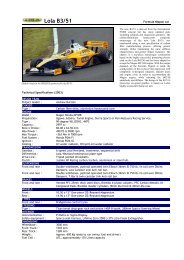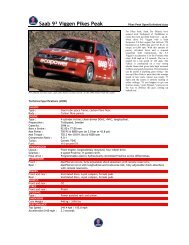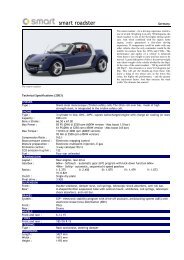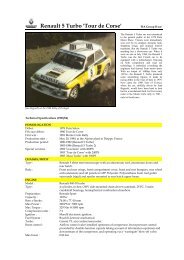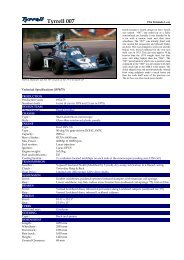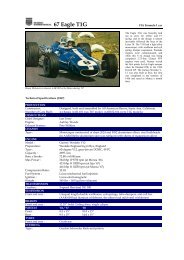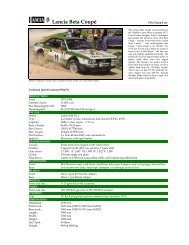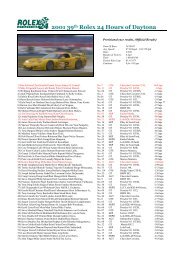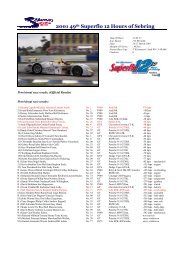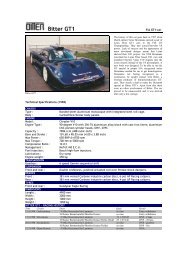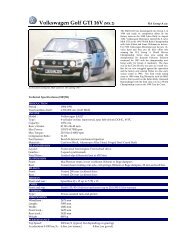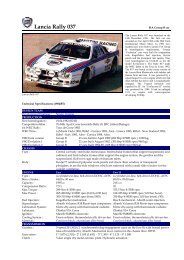70 Chaparral 2J - Motorsports Almanac
70 Chaparral 2J - Motorsports Almanac
70 Chaparral 2J - Motorsports Almanac
You also want an ePaper? Increase the reach of your titles
YUMPU automatically turns print PDFs into web optimized ePapers that Google loves.
continued to create innovative open-cockpit sports cars. The 1969 <strong>Chaparral</strong> 2H was originally designed to be a<br />
streamlined coupe, with the driver in a prone position looking through a plexiglass nose. However, John Surtees, the<br />
driver hired by Jim Hall to drive the car, convinced the team to open the cockpit for a more conventional appearance<br />
and driver position. Although the innovative design may have eventually proved successful, differences of opinion<br />
between Surtees and Hall resulted in the <strong>Chaparral</strong> 2H never living up to the team's expectations. The car's best finish<br />
was a 4th at a race in Edmonton, Canada. To appease his driver, Hall even purchased a McLaren M12 for use in the 1969<br />
Can-Am series, but that car's best finish was a 3rd place finish at the Mosport Can-Am race. The last U.S. road racing<br />
<strong>Chaparral</strong> was the <strong>2J</strong>, a boxy design that hid an innovation so potentially successful that it resulted in the car being<br />
banned. The <strong>Chaparral</strong> <strong>2J</strong>, affectionately known as the "Sucker Car," sported a snowmobile engine attached to two fans<br />
that sucked air from the bottom of the car and pushed it out the back. This created a vacuum that held the <strong>Chaparral</strong> <strong>2J</strong><br />
to the track like it was on rails. Although it raced only four times, not long enough to work out some of its "bugs," the <strong>2J</strong><br />
gave warning to competitors that it would be unbeatable when its reliability problems were solved. Unfortunately for<br />
Jim Hall, however, the FIA, the international race sanctioning body, banned the <strong>2J</strong> because it used "illegal moving<br />
aerodynamic devices." In 1966 and 1967, Jim Hall decided to take his successful <strong>Chaparral</strong>s to Europe to compete in the<br />
FIA World Sports Prototype Championship, going up against the world's best, including Shelby's GT-40s, Ferrari, and<br />
Porsche. The car used for the 1966 FIA season was the <strong>Chaparral</strong> 2D, a coupe version of the 2A that was very similar to<br />
Hall's original design for the <strong>Chaparral</strong> 2A. The resemblence to the Chevrolet Monza GT concept car is unmistakable.<br />
With drivers Phil Hill and Jo Bonnier, the <strong>Chaparral</strong> 2D managed a victory in the 1000 Km race at the demanding<br />
Nurburgring in Germany. The car DNF'd in three other FIA races that year. Although the 2D also competed in the first<br />
two races of the 1967 FIA season (Daytona and Sebring), the main entrant was the new <strong>Chaparral</strong> 2F, a coupe version of<br />
the high-winged 2E. Although the car was competitive, Phil Hill and Mike Spence only finished one of the eight FIA<br />
races in which it was entered. At least the last race (also the car's last race) resulted in a victory in the 500 Km. race at<br />
Brands Hatch. Jim Hall's <strong>Chaparral</strong>s didn't win any international championships, as Carroll Shelby's Cobras and GT-<br />
40s did. But Jim Hall and his <strong>Chaparral</strong>s dominated unlimited class sports car racing in the United States during the<br />
mid-1960s. To this day, very few race cars, of any type, have included and successfully demonstrated the aerodynamic<br />
innovations that Jim Hall built into succeeding versions of his <strong>Chaparral</strong>. The "Texas Road Runners" are truly a part of<br />
American racing history!<br />
JIM HALL AND HIS FABLED CHAPARRALS by Pete Lyons<br />
Troy Rogers stands ready beside the louver-bedecked <strong>Chaparral</strong> 2, just as he used to. Jim Hall settles once more into the<br />
composite cockpit that he molded around himself back in 1963. It fits his still-lean, lanky frame perfectly—as does his<br />
old driver’s suit. The ingrained starting drill comes back as readily: First plant your left foot on the brake and shove the<br />
shifter into low, and only then fire the Chevy. The aluminum small-block lights instantly, its eight stub stacks emitting a<br />
vigorous, eager crackle. At least old race cars can hold onto their youth. This one is already straining to go, churning the<br />
oil in the torque converter, held back only by the brakes. Hall simply releases them, and this ivory apparition from a<br />
distant time is free to run again. As the historic machine accelerates onto the Road America track, scene of two of its<br />
great victories in 1965, the converter keeps the engine at a constant growl while velocity builds. It’s like the steady roar<br />
of a Reno air racer on takeoff... except that here a resonance comes back from deep in the Wisconsin woods. Is it merely<br />
sonic reflection from thousands of trees? Or is it an echo from the glory years? That exciting era when the Road Runners<br />
from Texas were not only the dominant force in American sports car racing, but an astounding, fabulous, phenomenal<br />
leap forward in the world’s very conception of a racing car. If today, looking back, the whole <strong>Chaparral</strong> story sounds<br />
like a myth... well, that’s pretty much how it seemed then, too. See if you can sell this one to the movies. There’s a little<br />
bunch of amateur sports car racers, see, who hail from the scrub-brush obscurity of West Texas. Just the place to<br />
manufacture state-of-the-art road race cars, right? Anyway, every so often these guys pop up at the continent’s top<br />
tracks, where they unload home-built specials so novel they drop jaws, and so fast they threaten to win every time out.<br />
Plastic chassis... aluminum replicas of iron production engines... “automatic” transmissions... driver-operable “flipper”<br />
wings mounted upside-down... one car that is half roadster, half coupe... another with a second engine and extractor<br />
fans to clamp the car to the road like a giant suction cup... all produced in a secret lab, complete with a private test track.<br />
Hey, let’s call it “Rattlesnake Raceway.” Our hero is a wealthy young oilman who’s tall and slim and looks good in a<br />
cowboy hat. Plus, he’s an excellent race driver—a former F1 driver, no less—as well as a brilliant, imaginative race car<br />
designer. And, and, how about we give him a clandestine engineering liaison with the world’s largest automaker.<br />
Preposterous! But true. All that happened. And here to prove it is tall Jim Hall with four of his <strong>Chaparral</strong>s. His long<br />
racing career finally, firmly behind him, Hall is living a quiet, reclusive life. He and wife Sandy have become very<br />
serious about golf. But only days shy of his 66th birthday, he has come to RA to be grand marshal at the BRIC—the<br />
Brian Redman International Challenge, a vintage event named for the driver who won three champion-ships in Hallmanaged<br />
F5000 cars, 1974-76. Grand marshal: It’s a cloak of honor that must drape awkwardly over the shoulders of a<br />
hard-core, no-nonsense racer. And as the weekend develops, this very private man must be surprised by the endless<br />
throngs of people who want to see him, speak with him, ask him to sign something. The surprise is evident in the<br />
gracious “Thank you,” he returns along with the autograph. Other things feel unfamiliar today, too. <strong>Chaparral</strong> Cars<br />
used to tow its fantastic machines on open trailers; to the team they were just disposable raceware. This time they’ve<br />
been transported in 18-wheel splendor; rumor says they’ve been specially insured for $2 million—each. Back home in<br />
Midland, plans are afoot to build a museum around them. Opening is scheduled for 2003. It won’t have to be a very big<br />
building. People who remember all those Road Runners in all those races are always amazed to learn the actual total<br />
number of <strong>Chaparral</strong>-built sports car chassis: just seven. Six still exist, now lovingly restored by Rogers, one of the<br />
craftsmen who built them originally in Texas. (A series of five front-engined predecessors named <strong>Chaparral</strong> 1s came



